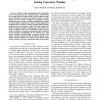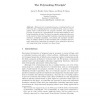18 search results - page 2 / 4 » The size-change principle for program termination |
ICTAC
2004
Springer
13 years 10 months ago
2004
Springer
We give an inductive method for proving weak innermost termination of rule-based programs, from which we automatically infer, for each successful proof, a finite strategy for data...
CDC
2010
IEEE
13 years 10 days ago
2010
IEEE
Dynamic airspace configuration (DAC) algorithms strive to restructure the U.S. National Airspace System (NAS) in ways that allow air traffic control to better manage aircraft flows...
ICALP
2005
Springer
13 years 10 months ago
2005
Springer
Although every terminating loop has a ranking function, not every loop has a ranking function of a restricted form, such as a lexicographic tuple of polynomials over program variab...
POPL
2005
ACM
14 years 5 months ago
2005
ACM
on Predicate Abstraction and Fair Termination Andreas Podelski Andrey Rybalchenko Max-Planck-Institut f?ur Informatik Saarbr?ucken, Germany Predicate abstraction is the basis of m...
ICFP
2005
ACM
14 years 5 months ago
2005
ACM
Proof-carrying code (PCC) is a general framework that can, in principle, verify safety properties of arbitrary machine-language programs. Existing PCC systems and typed assembly l...


